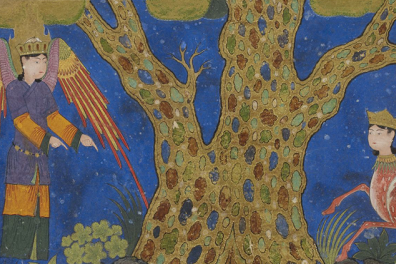International symposium: "The legacy of Abū ʿAbd al-Raḥmān al-Sulamī. On the occasion of the millennium of his death", December 9-10, 2021.

Event organized by Centre d'études et de recherche Moyen-Orient Méditerranée - CERMOM (Inalco).
Thursday, December 9 and Friday, December 10, 2021 - Maison de la recherche - Auditorium Georges Dumézil
Inalco, Maison de la recherche - 2 rue de Lille, Paris 7ème.
- To attend this scientific event on site, you need to register by clicking here.
Please note: you will be asked for your health pass at the entrance to the facility.
- To follow along remotely, here is the Link Zoom
Organizing Committee
Jean-Jacques Thibon (CERMOM, Inalco)
Francesco Chiabotti (CERMOM, Inalco)
Faezeh Beknaveh-Haller (CERMOM, Inalco)
Nadir Boudjellal (CERMOM, Inalco)
CONTACTS
jean-jacques.thibon@inalco.fr and francesco.chiabotti@inalco.fr
The legacy of Abū ʿAbd al-Raḥmān al-Sulamī. On the occasion of the millennium of his death
Muḥammad b. Ḥusayn Abū 'Abd al-Raḥmān al-Sulamī passed away exactly one millennium ago this year. For all those interested in the founding period of Sufism, he is a key figure who, through an abundant body of work, collected, organized and transmitted the teachings of the early Sufis. Heir to one of the learned families of Nishapur, at a time when the Khurasan metropolis was experiencing intense intellectual activity enabling it to rival Baghdad, this figure represents an essential link in the history of early Sufism. Muḥaddith by training and family tradition, he appears as a historian of Sufism writing a monumental history, Ta'rīkh al-ṣūfiyya, which survives only through quotations from later authors. His Ṭabaqāt al-ṣūfiyya constitutes a history of the doctrine of Sufism through the teachings of its early masters, in an attempt to unify a spirituality still very much dependent on local contexts. It is completed by a pamphlet exclusively dedicated to women, which may be one of the first of its kind (Dhikr al-niswa al-muta'abbidāt al-ṣūfiyyāt). In addition, he composed a set of texts related to Sufi practices, often cited under the title of Sunan al-ṣūfiyya, which has not come down to us. Some of the minor treatises, generally organized thematically (samā', adab, rukhaṣ, etc.), could represent fragments of this 'Summa'. He was also an exegete: his Ḥaqā'iq al-tafsīr, supplemented by the Ziyādāt, compile one of the first exegeses composed exclusively of the words of Sufis and cover the entire Qur'anic text, though without offering glosses for all its verses. Moreover, some of his works are among the rare testimonies documenting currents that subsequently disappeared or underwent profound evolutions, such as that of the Malāmatiyya or the Futuwwa of the Khurāsān.
The organization of this prolific work, which covers all the themes of interest to the Sufis of his time, responds to the necessities of an era in which the various sciences are in the process of being constituted, listing their authorities, defining their principles, refining their methodology and purpose. Sufism intended to occupy a place of its own among the sciences of Islam, and this work helped to define the contours of what would come to be known as taṣawwuf (to designate the science of the Sufis) and ṣūfiyya (to designate the men who claimed it or related to it). From the time of Sulamī onwards, these terms came to be used to designate the various forms of spirituality.
The work is therefore voluminous and, fortunately for us, benefited from wide distribution, so that the list of titles that have come down to us is close to fifty. Although it is almost entirely dedicated to Sufism, this work does not easily reveal its author's links with Sufism. Was Sulamī himself a Sufi master? The question remains open.
Abū 'Alā' al-'Afīfī was the first to publish a complete text by Sulamī in Cairo in 1945 with the Risāla al-malāmatiyya. A text of which R. Hartmann had proposed an analysis in a pioneering article (Der Islam 8, 1918). Subsequent editions of texts belonging to his work date from the 1950s (M. J. Kister, F. Taeschner, N. Shurayba). This editorial work continued in subsequent decades (J. Pedersen, P. Nwyia, E. Kohlberg, S. Ates, N. Zeidan). Academic work accelerated in the 1990s. The majority of Sulamī's known texts are now edited, thanks in particular to the scholarly efforts of G. Böwering and B. Orfali, and to the undertaking to publish the complete works of N. Pourjavadi (three edited volumes and the fourth in press), which bring together edited, but sometimes not easily accessible, texts and others edited for the first time. Theses have been written on this author (L. Berger, J.-J. Thibon, J. Welle, S. Z. Chowdhury and doubtless others in the Arab and Iranian worlds). Numerous articles have addressed this or that aspect of his work (see bibliography). A large number of translations have been published in French, German, English, Italian and Turkish (R. Deladrière, R. E. Cornell, E. Biagi, F. Colby, K. L. Honerkamp, T. Bayrak, F. Langmayr, F. Skali, G. Sassi, G. Rizzo, D. Giordani, J.-J. Thibon). This list is not exhaustive, but allows us to appreciate the success and research potential represented by Sulamī's works.
The contributions submitted will address the following issues:
- The context in which this work is produced and consideration of the works of his immediate predecessors, Kālābādhī, Sarrāj, Muḥāsibī etc...
- Contributions to a better knowledge of Sulamī's life and milieu
- Does Sulamī's work mark a turning point in the history of Sufism?
- The impact of his work on later Sufism
- The topicality of Sulamī's work: what legacy?
- The avenues still to be explored around Sulamī's work